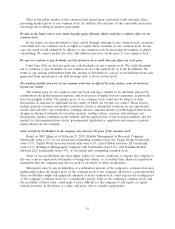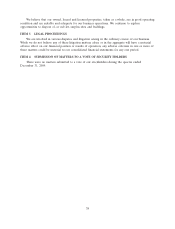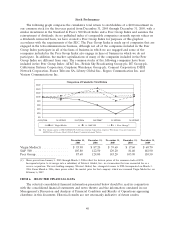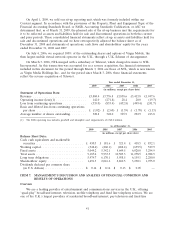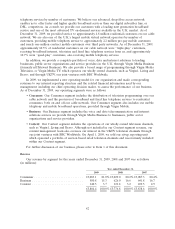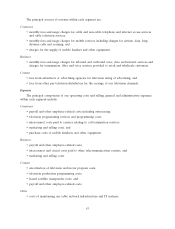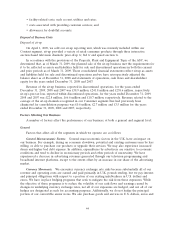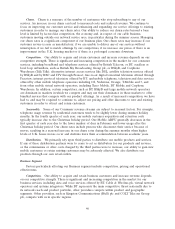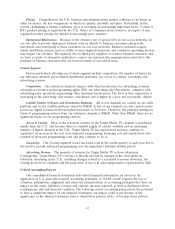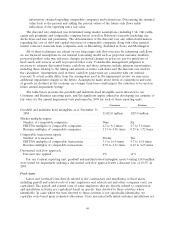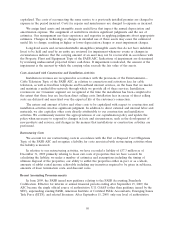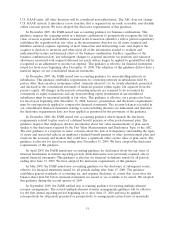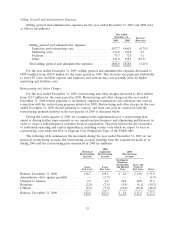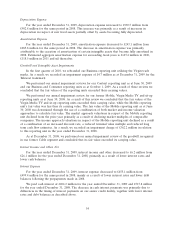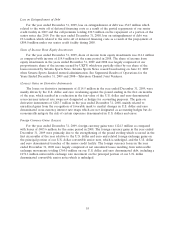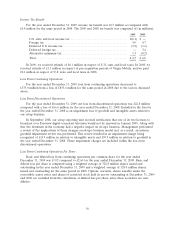Virgin Media 2009 Annual Report Download - page 48
Download and view the complete annual report
Please find page 48 of the 2009 Virgin Media annual report below. You can navigate through the pages in the report by either clicking on the pages listed below, or by using the keyword search tool below to find specific information within the annual report.Churn. Churn is a measure of the number of customers who stop subscribing to any of our
services. An increase in our churn can lead to increased costs and reduced revenue. We continue to
focus on improving our customer service and enhancing and expanding our service offerings to existing
customers in order to manage our churn rates. Our ability to reduce our churn rates beyond a base
level is limited by factors like competition, the economy and, in respect of our cable business,
customers moving outside our network service area, in particular during the summer season. Managing
our churn rates is a significant component of our business plan. Our churn rates may increase if our
customer service is seen as unsatisfactory, if we are unable to deliver any of our services without
interruption, if we fail to match offerings by our competitors, if we increase our prices, if there is an
improvement in the U.K. housing market or if there is a prolonged economic downturn.
Competition. Our ability to acquire and retain customers and increase revenue depends on our
competitive strength. There is significant and increasing competition in the market for our consumer
services, including broadband and telephone services offered by British Telecom, or BT; resellers or
local loop unbundlers, such as British Sky Broadcasting Group plc, or BSkyB, and Carphone
Warehouse (Talk Talk); alternative internet access services like DSL; satellite television services offered
by BSkyB and by BBC and ITV through Freesat; free-to-air digital terrestrial television offered through
Freeview; internet protocol television offered by BT; and mobile telephone, television and data services
offered by other mobile telephone operators including O2, Vodafone, Orange, T-Mobile and 3, and
from other mobile virtual network operators, including Tesco Mobile, BT Mobile and Carphone
Warehouse. In addition, certain competitors, such as BT, BSkyB and large mobile network operators
are dominant in markets in which we compete and may use their dominance in those markets to offer
bundled services that compete with our product offerings. As a result of increased competition, we have
had to, and may be required to continue to, adjust our pricing and offer discounts to new and existing
customers in order to attract and retain customers.
Seasonality. Some of our Consumer revenue streams are subject to seasonal factors. For example,
telephone usage revenue by residential customers tends to be slightly lower during summer holiday
months. In the fourth quarter of each year, our mobile customer acquisition and retention costs
typically increase due to the Christmas holiday period. Our Mobile ARPU generally decreases in the
first quarter of each year due to the fewer number of days in February and lower usage after the
Christmas holiday period. Our churn rates include persons who disconnect their service because of
moves, resulting in a seasonal increase in our churn rates during the summer months when higher
levels of U.K. house moves occur and students leave their accommodation between academic years.
Distribution. We primarily rely upon third parties to distribute our mobile products and services.
If any of these distribution partners were to cease to act as distributors for our products and services,
or the commissions or other costs charged by the third parties were to increase, our ability to gain new
mobile customers or retain existing customers may be adversely affected. We also distribute our
products through our own retail outlets.
Business Segment
Factors particularly affecting our Business segment include competition, pricing and operational
effectiveness.
Competition. Our ability to acquire and retain business customers and increase revenue depends
on our competitive strength. There is significant and increasing competition in the market for our
business services, including data and voice services offered by BT, Cable & Wireless plc, virtual network
operators and systems integrators. While BT represents the main competitive threat nationally due to
its network reach and product portfolio, other providers compete within product and geographic
segments. Other providers, such as Kingston Communications (Hull) plc and COLT Telecom Group
plc, compete with us in specific regions.
46


